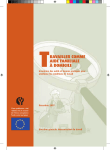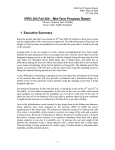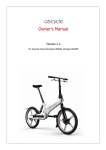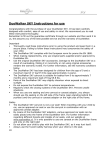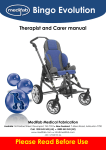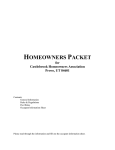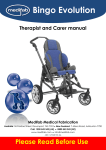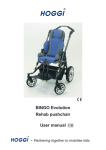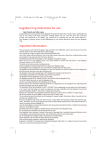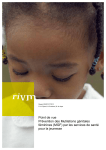Download choosing the right baby gear
Transcript
safe baby products choosing the right baby gear why is this brochure important for you to read? Why is this brochure important for you to read? Every day, hundreds of children end up at the doctor’s or even the hospital because of an accident in or around the home. Obviously, all parents-to-be want to avoid this. And we’re here to help. This brochure helps you choose safe products for your child. Take this brochure with you In this brochure, we provide practical tips on buying and using each product. Take it with you to the shop, so that you know what to look for when considering your options. And read through it again when you start using the products, so that you’ll know you’re using them safely. VeiligheidNL VeiligheidNL has been a safety expert for more than 30 years. You can take advantage of our expertise when preparing for the arrival of your baby. As your child grows and develops, you can also trust VeiligheidNL to provide you with a wealth of information on safe playing, sleeping, bathing, bicycling, playing sports and much more. After all, you want your child to develop in a safe, loving and secure environment! Have a look at www.veiligheid.nl/kinderen. This brochure is part 1 of the ‘Growing Up Safely’ series. The other 4 brochures in this series that you will receive from the Kraamzorg post-natal care service or the consultatiebureau health centre are: • Sleep Tight (0-2 years) • Good Start (0-6 months) • Playful Exploring (6-12 months) • Fun on the Go (1-4 years) contents 4 bassinet 14 bicycling with baby 5 cot 16 bicycle trailer 6 cot mattress 17 carrier cycle 7 travel cot 18 changing table 8 bedding 19 bouncy seat 9 hot water bottle 20 playpen 10 sling and baby carrier 21 highchair 11 pram 22 more information 12 car seat 3 bassinet A bassinet is intended for children up to the age of around 6 months. A bassinet is smaller than a cot, so that it fits more easily next to your own bed or in the living room. Incidentally, it is not necessary to use a bassinet; you can also have your baby sleep in a cot from day one. buying tips • The bassinet should be at least 27.5 cm deep. • The bassinet should have a maximum length of 90 cm. • The bottom of the bassinet should let air pass through it. • The bottom should be flat and sturdy and fit snugly against the sides of the bassinet. There should not be any holes (cutouts) or trim where a small hand or foot can get trapped. • Air should be able to pass through the sides of the bassinet. The openings should be no more than 6.5 cm wide or long. • The bassinet bedding should fit tightly and securely. Important: your child can suffocate if soft, padded bedding or pillows are in the bassinet. • The bassinet should not have any sharp edges or points. Is the bassinet made of wicker or rattan? Examine it closely. • The bottom of the bassinet should be sturdy. The bassinet should not move if an older child pulls on it. 4 usage tips • Place the bassinet on a flat surface. • Make sure that your child cannot reach the canopy and remove it once your child becomes more active. • Do not let other children near the bassinet unattended. • Switch to a child’s bed once your child can roll over on his own. top of the cot should be 55 cm or more. Is the cot in the highest position? Then this distance should be 20 cm or more. • The cot should not have any sharp edges. There should be no splinters or protruding screws. • There should be no buttons or other objects on the top of the cot. Your child can get stuck on these. usage tips • Do not place the cot too close to a cot You child can sleep in a cot from birth. Prefer to have your baby sleep in a bassinet first? No problem. But children grow quickly and become more and more active, so it is advisable to switch to a cot once your baby is between 3 and 6 months old. buying tips • The cot should be between 90 and heater or radiator. Do not place the cot too close to an open window or curtains either. Blind and curtain cords are also dangerous. • Do not put any pillows or stuffed animals in the cot. And do not use a bumper against the walls of the cot. • Never strap your child into a bed. Your child may roll over and suffocate. • Adjust the bottom of the bed to the middle position once your child can roll over. • Adjust the bottom of the bed to the lowest position once your child can sit up. 140 cm long. • The sides of the cot should allow air to pass through. Many cots have bars for this purpose. The distance between the bars should be between 4.5 and 6.5 cm. The bars should run vertically to the bottom of the cot. • You should be able to raise or lower the bottom of the cot. Is the cot in the lowest position? Then the distance between the top of the mattress and the 5 cot mattress Young children spend many hours in their cot each day. That is why it is important to buy a high-quality, safe mattress. buying tips • The mattress should be firm, so that your child cannot lift the mattress himself. Your child should not be able to get under the mattress either. • The mattress should be flat without any lumps or dips. • Do you already have a cot, but no mattress? Measure the inside of the cot carefully first, to make sure the mattress fits snugly in the bed. It should be easy to place it in the cot without any gaps between the mattress and cot. Otherwise, your child could get trapped between the mattress and the side of the bed. 6 • The mattress should not be too soft or your child’s face could get buried in it, causing your child to suffocate. To check whether the mattress is too soft, press on it with a flat hand and outstretched arm. If it’s firm enough, you will only be able to press it in slightly. • Never buy a mattress with a plastic cover, as this can cause your child to suffocate. Also, a plastic cover is warm and this material does not let fresh, clean air pass through it. • Do not use a bead-filled mattress. Your child’s head can get buried in it. If your child rolls onto his tummy, he can suffocate. travel cot A travel cot is also referred to as a portable crib. It can be folded up, making it convenient for taking on holiday or when your child is spending the night away from home. to press two spots or use considerable force to fold it. This way, only an adult is able to fold the travel cot. • There should not be any sharp objects on the travel cot. • There should not be any V-shaped buying tips • Your child should not be able to climb or fall out of the cot. The sides should therefore be at least 55 cm high. Measure from the top of the mattress. • The fabric on the sides of the travel cot should have holes, so that air can pass through. These holes should be no larger than 7 mm. You can test whether the holes are too large by sticking a regular pencil through them. If the pencil is just able to pass through, the holes are not too big and your child will not be able to get his fingers stuck in them. • The fabric should be tightly adhered to the frame. If the fabric is too loose, both your child and the cot can tip over. • The bottom of the travel cot should not sag. • This means that the cot cannot accidentally fold up. It is safe if you need openings in the cot. Your child could get stuck in these. • The mattress should not be too soft or too thin. Otherwise your child could get under it. usage tips • Always check whether the travel cot is folded out completely. • Check that all fasteners are secure. • Never place an extra mattress in the travel cot, not even if it is designed for use in a travel cot. Your child could get trapped between the mattress and the flexible side of the bed. • Do not use a travel cot as an everyday cot, since the mattress is usually too thin and air cannot pass through the bottom. Use a regular cot (crib) at home with a thick mattress. 7 bedding Naturally, your baby also needs bedding. There are different options: a baby sleeping bag, blanket and sheet, or a blanket in a duvet cover. It is important that your baby is warm enough. But if your baby becomes too warm, this can be dangerous. That’s because it increases the chance of cot death (SIDS). You can tell whether your child has the right temperature by checking whether his feet and neck feel comfortably warm. buying tips • Do not buy a comforter for your baby. These are much too warm. • Buy a sleeping bag instead. Then you will not need a blanket and your baby will never run the risk of getting his face under the blanket. • Make sure the baby sleeping bag fits snugly. The holes for the arms and neck should not be too large. If your baby is able to get his head or arms inside the sleeping bag, he can suffocate. • Do not buy a baby sleeping bag with buttons, but with a zipper, since buttons can come off easily. • The zipper should zip from top to bottom. This way, your baby will not be able to open the zipper. • Still want to use a blanket? You should be able to tuck the blanket and sheet or duvet cover firmly under the mattress. So they need to be wide and long enough for this. • Do not buy a blanket that is too thick. The thicker the blanket, the hotter it is. • And do not buy any pillows because 8 these are not safe for your child during the first two years. usage tips • Check the temperature in the room where your baby sleeps (even if it’s your own bedroom in the beginning). The best temperature is 16-18°C. • Always make sure there is enough fresh air. • Make up the bed short, as shown in the illustration. This way, your baby will have his feet close to the end of the bed. The sheet and/or blanket will then reach his shoulders. This way, your baby will never end up with his head under the sheet and/or blanket. • Is the bedding too large? Fold it under the mattress. Folding a blanket double usually makes it too warm for a baby. hot water bottle A hot water bottle or heat pack is used if a newborn is not yet able to regulate his own temperature. It can also be used if your child is ill. There are different types of products to choose from: • Hot water bottles. These are filled with hot water and are made of metal or plastic. • Heating bag filled with seeds. These are heated up in the microwave. • Gel pack. The gel maintains the heat. These are also heated up in the microwave. • Electric water bottles. These work on electricity. buying tips • Make sure the product comes with instructions in English. • Are you buying a hot water bottle? Pay attention to 3 things: • There should not be any seams. • The top of the bottle should have a long screw thread that you need to rotate several times to open or close the bottle. • The top should have a rubber seal. • An electric water bottle should switch off automatically when it reaches the right temperature. • Do not buy a hot water bottle or cover shaped like an animal. A hot water bottle is not a toy. usage tips • Only use the heating product to warm up the bed. Your child should not sleep with the hot water bottle or heat pack in the cot. • It is sometimes necessary to use a heating product in the cot right after your baby is born. But this should only be done after consulting an expert. Do not use a cherry pit heating pad for reasons of fire hazard. • Place a cover around the hot water bottle or heat pack. Make sure the cover is fastened securely! • Always check to make sure no water is leaking from the hot water bottle. • Never place an electric hot water bottle in your child’s cot if it is still plugged into the socket. 9 sling and baby carrier You can carry your baby in a sling or baby carrier. There are various types from which to choose. Some slings need to be tied completely yourself. With a little practice, you will discover all kinds of ways you can carry your child in it. Other slings are pre-shaped and you simply place your child in it. With a baby carrier, your child is carried in an upright position. buying tips • Make sure your child has enough support for his back and head. A young child cannot keep his head upright for very long. • It is advisable not to buy a sling or baby carrier in which your baby is carried horizontally. Because of the shape of the carrier, it covers part of your baby’s face and your child lies with his back curved, making it more difficult to breathe. • The sling or baby carrier should be made of soft fabric. There should not be any sharp corners or edges. • Try on the different models in the shop, preferably with your baby in it, so that you can feel whether the sling or baby carrier is comfortable for you and your child. usage tips • Always fasten the sling or baby carrier securely. sling • Make sure your child can breathe freely at all times. Never carry your child under a closed jacket. • Make sure your child is placed in the carrier securely. The baby carrier is in the right position if you can kiss your child on his head. • Do not carry your child in a sling or carrier when cooking, in the car, on a motorcycle, on a bicycle or when playing sports. • Important: Always hold on to your child when bending forward. baby carrier 10 pram pushchair pram There are numerous types of prams and pushchairs from which to choose. A pram has a flat bottom and is designed for babies aged 0 to 6-9 months. A pushchair or buggy is a pram with a seat. It is intended for children who can sit up on their own. With a combination pram, you use the same frame for both the pram and, later on, the pushchair. Determine which type is most convenient for you. There are lightweight and heavier prams in the market. Will you be travelling often with your baby by car, bus or train? Choose a lightweight and easily collapsible pram. Will you be doing lots of shopping or lots of walking with the pram? Choose a heavier model. • The pram should be stable and not tip over, not even when your child is hanging over the edge or another child is pulling on the pram. • The brake should lock two or more wheels. You should be able to easily apply the brakes on the pram. • Make sure the pushchair seat can recline, preferably including lie-flat. When your child gets tired, he can nap in comfort. • Buy a pushchair with a 5-point harness. usage tips • Apply the brakes before placing your child in the buggy. buying tips • Always secure the harness immediately • Buy a buggy with good and clearly • Never leave your child unattended in the written user instructions. Ask the shop assistant to show you how it works. after placing your child in the pushchair. buggy. Stay close by. • Try it out in the shop: fold it, push it, • Do not hang a heavy bag from the • Buy a pram with a large bassinet, so you • Prevent little fingers from getting trapped. turn it, cross thresholds with it and adjust the handlebar. can use it for a longer period of time. handlebar. Use a basket under the buggy instead. Do not fold or unfold the pushchair if your child is standing right next to it. 11 car seat Travelling by car with your child? According to the law, this may only be done using an approved car seat. There are different types available: rear-facing infant car seats, child car seats and booster seats. Want to know which seat is most suitable for your child? Follow the selection guide at www.veiligheid.nl/autostoeltjes. buying tips • Always buy an approved car seat. An approved car seat bears a label of approval. This label is found on the back of the seat. The sticker is usually orange and states ECE/R44 or i-Size. • With the new i-Size car seats, the seat must be appropriate for your child’s height. • With car seats to which the ECE safety standard applies, the seat must be appropriate for your child’s weight. Choose the seat that lets your child travel in a rear-facing position for as long as possible. This is the safest position. • Check to make sure the seat fits in your car. An i-Size seat requires an ‘i-Size ready’ seat in the car and an ISOFIX seat requires ISOFIX attachment points. • Age is often used as the standard when buying a seat, but keep in mind that children of the same age can have different weights and heights. • Bring your car when buying a car seat and check to make sure the seat can be installed correctly in the front and back seat of the car. Have the shop assistant show you how to install it. • It is preferable not to buy a used car seat. The car in which the seat was used may have been involved in an accident, making the car seat no longer safe. 12 usage tips • Make sure the car seat is fastened securely. Check the user manual to make sure the seat is installed correctly. Not sure? Ask an expert for advice, such as from the shop where you purchased the car seat. • If possible, always install the car seat on the back seat of the car. • Need to use the front seat? Always make sure the air bag is switched off when your child is travelling in a rear-facing car seat (infant car seat or i-Size). Is your child facing forward? Slide the passenger seat as far back as possible. • Fasten the safety belt tightly. Is your child wearing a thick coat? Remove the coat first. In the event of a collision, a bulky coat will compress, making the harness very loose! If it’s cold, place a blanket on top of your child after fastening the harnesses. • If your baby is very small, use a special car seat reducer. • Do not let your child spend longer than 2 hours a day in an infant car seat or bouncy seat. It is important that your child does not get cramped up and is able to move. 13 bicycling with baby Want to take your baby for a bike ride? There are several options: • In an infant car seat or baby safety seat securely installed in a bicycle trailer or carrier cycle. It is advisable to place the car seat in a rear-facing position. • In an infant car seat attached to the bicycle using a special frame. • Can your child sit from a crawling position without any help? Then your child can ride in a bicycle seat. tips • It is preferable that the saddle of the bike is not too high. This lets you easily put your feet on the ground. Make sure the brakes are working properly and do not ride too fast. 14 • Make sure the car seat or baby safety seat is secured properly. Special mounting sets are available for use in a bicycle trailer/carrier cycle. • Always secure your baby in his seat with the harnesses. • Keep a close eye on your child. Make sure he is comfortable and try to avoid wobbling and jolts. • Strong wobbling can often be prevented by adding extra weight to the trailer/ carrier (another child, groceries or a bag of sand). • Don’t take very long trips to start with. Important: Never ride a bicycle with your baby in a sling. Your child is not sufficiently protected in the event of a fall or collision. buying tips usage tips • It should be possible to mount the seat • Go on short rides to start with. • Choose a route that has as few potholes, on the handlebar post or steering stem. Seats that are mounted on the handlebar itself are not suitable for aluminium handlebars. • Make sure that the brake and gear cables do not get tangled. The bicycle seat can prevent the handlebar from rotating completely, meaning it will not be possible to make a very sharp turn. • Test out the seat with your child in it. Make sure his feet cannot get caught between the spokes and/or little hands or feet do not get stuck while steering. bumps and speed bumps as possible. • Even though your child isn’t pedalling along with you, a bike ride is very exhausting for a small child. If your child starts crying, it’s time to take a break or to stop. For more buying and usage tips for bicycle seats, see www.veiligheid.nl/fietszitje. 15 bicycle trailer A bicycle trailer is a two-wheeled cart that is pulled along by a bicycle. One or two children can sit in a bicycle trailer. buying tips • Buy a bicycle trailer with a sturdy plastic bottom. • Buy a bicycle trailer that is highly visible: good rear light, reflective strips on the side, bright colours and a flag. • Make sure the bicycle trailer can be • Keep in mind that a bicycle with a bicycle trailer behind it is heavier and wider than a regular bike. You will be unable to brake as quickly and will need more room on the road. • Take wide turns. You are much longer with a bicycle trailer behind you. • Before starting off, always make sure that the trailer is attached to your bike securely. attached to the bike in two ways: using a coupling and a safety clip. • Always secure your child with the • The bicycle trailer spokes should be out • Attach a mirror to your handlebars. of reach of little fingers. 16 usage tips harness belt. This way you can see both the bicycle trailer and your child while riding. carrier cycle A carrier cycle is a two or three-wheeled bicycle with a box attached on the front. One to four children can sit in the box. usage tips buying tips • Take a test ride with the carrier cycle • Buy a carrier cycle that is highly visible, with a bright colour, good lighting and reflectors on the sides. • Make sure the wheels are protected, so that little fingers can’t get stuck in the spokes. • Make sure that all children have enough room to sit. Always strap them in. without children in it, but with extra weight in the box, such as a large sack of potatoes or gardening soil. • A carrier cycle is wider, longer and heavier than a regular bike. Keep this in mind at all times. • An advantage to a three-wheeled carrier cycle is that it won’t tip over easily. It also has a larger box than a twowheeled carrier cycle. • An advantage to a two-wheeled carrier cycle is that it is lighter and easier to ride. And it handles curves like a regular bike. 17 changing table A dresser or changing table is used to wash and dress your child and to store cleaning and washing products. It is one of the most frequently used pieces of furniture in a baby room and can often be used for years on end. buying tips • Buy a changing table with a raised edge on the side and back. This will prevent the changing pad from sliding off. • The changing table should not have any sharp edges or corners. • The changing table is sturdy, even when the doors or drawers are open. • The drawers should have a stop. This prevents them from falling out accidentally. • It is nice if you are able to place your feet under the changing table. This lets you get as close as possible to your child. • Can the top be folded down? Make sure it cannot fall down by itself. 18 usage tips • Never leave your child unattended on the changing table and always keep a hand on your baby in order to respond immediately to any unexpected movements. If you need to do something else, place your child in his cot. • Use a changing pad with raised edges. • Organise everything practically. Keep products you use often within easy reach. Lay out everything you will need beforehand. • Do not place the changing table too close to a heater or radiator. Blind and curtain cords are also dangerous. 5-point harness belt bouncy seat A bouncy seat is your child’s first chair. Your child can sit, lie, play and look around while in a bouncy seat. Your child can be placed in a bouncy seat after only a few weeks from birth. You can use a bouncy seat until your child is 6 to 9 months old or weighs 9 kilos. When your child is in his bouncy seat, you have your hands free yet are still close to your child. your child can lean back against the seat with his entire body. • The seat should have a properly functioning adjustment button. that lets you adjust the back. Test out the button in the shop. The back should not move unless you are using the adjustment button. usage tips • Place the bouncy seat on the ground. buying tips • The bouncy seat should be sturdy and stable. The frame of the bouncy seat should be wider than the seat itself. • The seat should have an anti-skid base. This keeps the seat stable on slippery floors. The bouncy seat should not slide around if your child is very active in it. • The bouncy seat should have a restraint belt. • The bouncy seat should provide your child with enough support. This means Want to feed your child at the table? No problem. But only place the seat on a high surface if you are right next to it. • Always secure your child with the harness belt. This well prevent your child from falling out of the seat. • Do not let your child spend more than 2 hours a day in the bouncy seat or a car seat. It is important that your child gets enough movement. • Want to use the adjustment button? Never do this when your child is in the bouncy seat. 19 playpen There are two different types of playpens: one with bars and one with netting. A box with bars is better for your child. A box with bars offers 3 advantages: • Your child can lean against the bars. • Your child can use the bars to learn to stand. • Your child has a good overview of the room from the playpen. The advantage of a box with netting is that it is lightweight, making it easy to take with you. A disadvantage is that your child cannot pull himself up using the netting. Also, your child cannot see the room easily because the holes in the netting need to be small for safety reasons (maximum of 7 mm, as with a travel cot). buying tips • The playpen should be sturdy and not have any sharp edges. • Does the playpen have an adjustable bottom? Check to make sure it is still stable and sturdy with the bottom in the highest position. • Check whether the gap between the bottom and side is no larger than 0.5 cm. • With a playpen with bars, the distance between the bars should be between 4.5 and 6.5 cm. With a playpen with netting, the holes in the netting should be no larger than 7 mm. • Do you have a foldable playpen? Check to make sure the playpen cannot accidentally fold with your child in it. usage tips • Do not place the playpen close to a heater, plant, open window or curtains. This is dangerous for your child. • Do not tie toys to the playpen using string or rope. • Is your child able to sit? Place the bottom of the playpen in the lowest position. • Do not put too many toys in the playpen. Your child can stack them to climb out of the playpen. • Do you have a playpen with netting? Check the netting regularly. Is it torn or has it come loose? If so, stop using the playpen because it is no longer safe. 20 highchair If your child is able to sit up on his own, use a highchair. A highchair lets your child sit at a table and eat with the family. buying tips • The highchair should be sturdy and stable. Push against all sides of the chair. The chair should not tip over. • The highchair should have a safety harness. The belt should at least have a crotch and hip strap, and preferably also shoulder straps. This well prevent your child from climbing or sliding out of the seat. • Is there no safety harness in the highchair? Buy a separate harness. The user manual will provide instructions on how to attach the harness to the highchair. • Make sure that a folding highchair has extra safety features. It should not be able to fold accidentally. usage tips • Always secure your child with the harness belt. This well prevent your child from standing in the seat or climbing out of it. • Is the highchair still a little too big for your child? Use a seat reducer. This will provide your child with enough support. • Never leave your child alone in the highchair, not even when secured in the harness belt. • Make sure your child cannot push his feet against the table. This could cause both your child and the highchair to fall over backwards. 21 more information For all info on Growing Up Safely, visit www.veiligheid.nl, both now and in the future as your child grows and develops. You can also download the Growing Up Safely app for a quick check as to whether your home is ready for you to bring home your baby. This brochure is part 1 of the ‘Growing Up Safely’ series. Afterwards, you will receive the following 4 brochures from the Kraamzorg post-natal care service or consultatiebureau health centre: 0–6 months sleep safely safe start a good start sleep tight Sleep Tight (0–2 years) Good Start (0-6 months) 1-4 years safety on the go fun on the go safe exploring 6–12 months the world at large Playful Exploring (6-12 months) 22 Fun on the Go (1-4 years) © VeiligheidNL This publication was prepared with the greatest possible care. VeiligheidNL assumes no liability for any inaccuracies. Amsterdam, February 2015
























